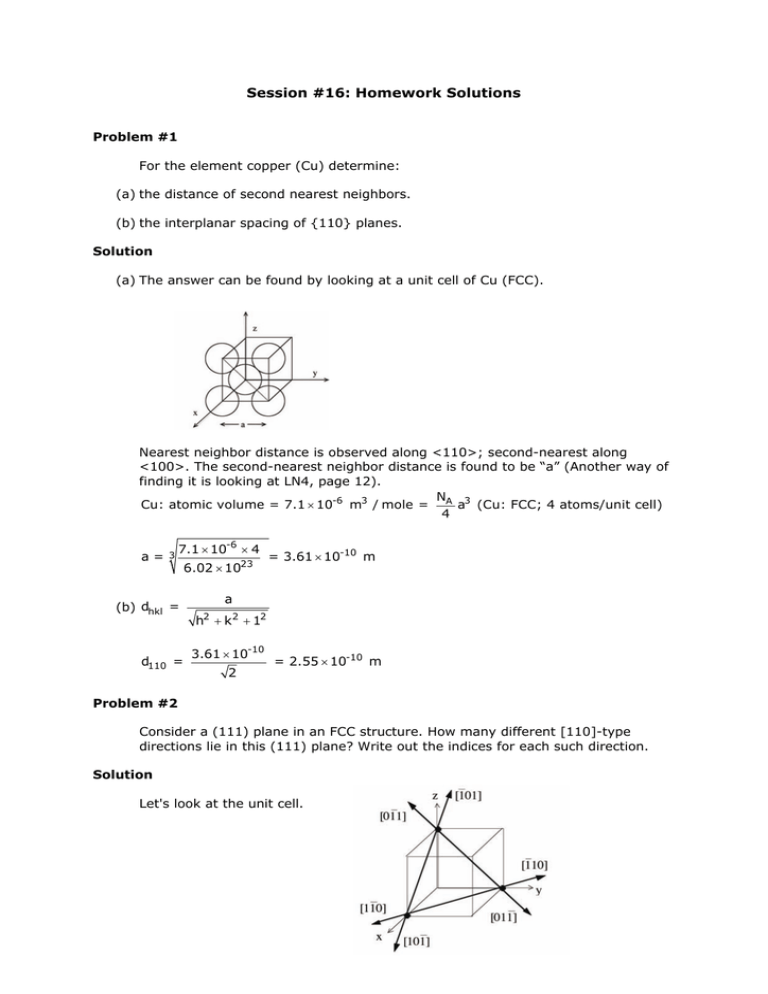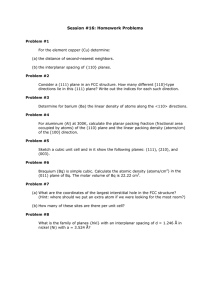Session #16: Homework Solutions
advertisement

Session #16: Homework Solutions
Problem #1
For the element copper (Cu) determine:
(a) the distance of second nearest neighbors.
(b) the interplanar spacing of {110} planes.
Solution
(a) The answer can be found by looking at a unit cell of Cu (FCC).
Nearest neighbor distance is observed along <110>; second-nearest along
<100>. The second-nearest neighbor distance is found to be “a” (Another way of
finding it is looking at LN4, page 12).
N
Cu: atomic volume = 7.1 × 10-6 m3 / mole = A a3 (Cu: FCC; 4 atoms/unit cell)
4
a=
3
7.1 × 10-6 × 4
(b) dhkl =
d110 =
23
6.02 × 10
= 3.61 × 10-10 m
a
h2 + k2 + 12
3.61 × 10-10
2
= 2.55 × 10-10 m
Problem #2
Consider a (111) plane in an FCC structure. How many different [110]-type
directions lie in this (111) plane? Write out the indices for each such direction.
Solution
Let's look at the unit cell.
There are six [110]-type directions in the (111) plane. Their indices are:
(101) , (101) , (110) , (110) , (011) , (011)
Problem #3
Determine for barium (Ba) the linear density of atoms along the <110> directions.
Solution
Determine the lattice parameter and look at the unit cell occupation.
Ba:
BCC; atomic volume = 39.24 cm3/mole; n = 2 atoms/unit cell
(
)
3.924 × 10-5 m3 / mole =
NA 3
a
2
a=
3
2 × 3.924 × 10-5
6.02 × 1023
linear density =
= 5.08 × 10-10 m
1 atom
a 2
=
1
5.08 × 10-10 × 2
= 1.39 x 109 atoms/m
Problem #4
For aluminum at 300K, calculate the planar packing fraction (fractional area
occupied by atoms) of the (110) plane and the linear packing density (atoms/cm)
of the [100] direction.
Solution
Aluminum at 300K has FCC structure:
Volume unit of a cell:
V =
10 cm3
1 mole
4 atoms
×
×
23
mole
1
unit cell
6.02 × 10 atoms
= 6.64 × 10-23 cm3 / unit cell
(
V = a3 → a = 6.64 × 10-23 cm3
For FCC:
)
1/3
2a = 4r → atomic radius r =
= 4.05 × 10-8 cm
(
)
2
2
a=
4.05 × 10-8 cm
4
4
= 1.43 × 10-8 cm
Planar packing fraction of the (110) plane:
area of shaded plane in above unit cell =
2a2
⎛1⎞
⎛1⎞
number of lattice points in the shaded area = 2 ⎜ ⎟ + 4 ⎜ ⎟ = 2
⎝2⎠
⎝4⎠
area occupied by 1 atom = πr2
packing fraction =
=
(
2 ( 4.05 × 10
area occupied by atoms
2πr2
=
total area
2a2
)
cm)
2π 1.43 × 10-8 cm
-8
2
2
= 0.554
Linear packing density of the [100] direction:
density =
1 atom
1 atom
=
= 2.47 × 107 atoms/cm
-8
a
4.05 × 10 cm
Problem #5
Sketch a cubic unit cell and in it show the following planes: (111), (210), and
(003).
Solution
(111) inverse =
1 1 1
→ x = 1, y = 1, z = 1
1 1 1
This plane intersects x-axis at x = 1, y-axis at y = 1, z-axis at z = 1
(210) inverse =
1 1 1
→ x = 1/2, y = 1, z = infinity
2 1 0
This plane intersects x-axis at x = 1/2, y-axis at y = 1, and does not intersect the
z-axis.
(003) inverse =
1 1 1
→ x = infinity, y = infinity, z = 1/3
0 0 3
This plane does not intersect either the x-axis or y-axis, and intersects the z-axis
at z = 1/3.
Problem #6
Braquium (Bq) is simple cubic. Calculate the atomic density (atoms/cm2) in the
(011) plane of Bq. The molar volume of Bq is 22.22 cm3.
Solution
(011) looks like this:
4x
1
atoms = 1 atom
4
area =
1
a3
=
2a2
NA
Vmolar
1/3
⎛ 22.23 ⎞
→ a= ⎜
⎟
⎝ 6.02 × 1023 ⎠
∴ atomic density =
1
2
2a
= 3.33 × 10-8 cm
= 6.376 × 1014 atoms/cm2
Problem #7
(a) What are the coordinates of the largest interstitial hole in the FCC structure? (Hint:
where should we put an extra atom if we were looking for the most room?)
(b) How many of these sites are there per unit cell?
Solution
(a) The largest “holes” are the octahedral voids formed by eight (8) contiguous
atoms, for example, around the center of an FCC unit cell. The location of the
center is therefore: 1/2, 1/2, 1/2.
(b) Where are the octahedral voids in the unit cell? One in the center, and ¼ void
centered on each edge. Since there are 12 edges, we have a total of (1 + 12/4)
= 4 octahedral voids in an FCC cell.
Problem #8
What is the family of planes {hkl} with an interplanar spacing of d = 1.246 Å in
nickel (Ni) with a = 3.524 Å?
Solution
a
We know: d(hkl) =
2
h + k2 + l2
h2 + k2 + l2 =
2
h +k
2
a
d(hkl)
=
2
3.524
= 2.828
1.246
+ l = 8 = (22 + 22 + 0)
The family of planes is {220}
MIT OpenCourseWare
http://ocw.mit.edu
3.091SC Introduction to Solid State Chemistry
Fall 2009
For information about citing these materials or our Terms of Use, visit: http://ocw.mit.edu/terms.




